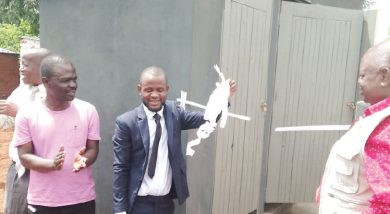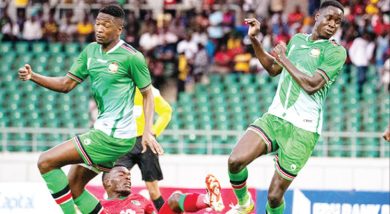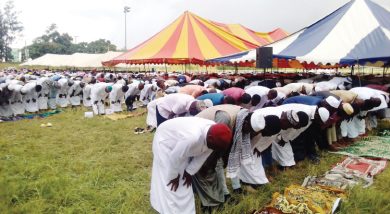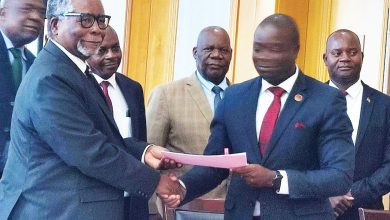Scramble for water part of daily life for millions in Malawi
It’s around 3am at Kauma, one of the poorest neighbourhoods in Malawi’s capital, Lilongwe. Eluby Matengula, in her late 50s, together with several other women, is already clamouring for water at one of the unprotected wells in the area.
She says fighting among women as they scramble for water is a common sight around here.

“Women sometimes accuse each other of depleting the water, resulting in some people going for days without water,” Matengula says. “Since independence [in 1964], up to this year, save for the only kiosk [water selling points] whose taps often run dry, this area has had no borehole, not even a single one. We drink water which is dirty.”
Matengula, looking tired, says that apart from the water kiosk, the only “reliable” community water source is a muddy well.
That, she explains, “bathes children, cleans laundry, and is shared by livestock, as well as members of the community alike.”
Scavenging for water
Matengula’s story is typical of poorer families living in Malawi, which spend much of their time scavenging for water from unprotected sources because the crippled economy means they cannot afford water from a community water selling points by Lilongwe Water Board (LWB).
Fifty-six years after independence, potable water is still a literal pipe-dream for many people in Lilongwe and elsewhere in Malawi.
According to the 2018 Population Housing Census, less than 10 percent of the (then) population of just over 17.5-million Malawians had access to piped water in their homes. Of these, 3.1 percent had water piped directly into their homes, while a further 6.3 percent had piped water available in their yards.
A further 61.7 percent of Malawians used boreholes for water and 8.1 percent used a community standpipe to access water.
The remaining people, comprising just over 20 percent of Malawi’s population, accessed water from “unprotected sources”, according to the PHC report.
Piped water is much safer than water from boreholes, because it is treated before being distributed to users. Many of the boreholes that residents rely on are broken down, forcing communities to seek less sanitary water sources.
The World Bank reports that unsafe drinking water and poor sanitation in both Malawi’s rural and urban areas remain a binding constraint on the country’s growth and poverty reduction: “Malawi’s development challenges are multi-pronged, including vulnerability to external shocks such as weather and health. Other challenges include rapid population growth and environmental degradation.”
The bank estimates that Malawi loses about $3.8 (K2 850) per capita or 1.1 percent of the country’s gross domestic product (GDP) due to poor health outcomes attributed to, among other things, low access to safely managed sanitation services, dwindling water resources, lagging infrastructure development, and aging water systems that create large gaps between supply and demand, leading to unreliable services.
Waterborne diseases
Another common problem occurs when the water utility board does not install any of these kiosks in an area, or when those who are meant to run these water selling points do not show up for work.
A young mother Eliza Zidana explains: “It’s impossible for all us to draw water during the day at the water kiosk. So, some of us come at night, while others try their luck during the day at this well here.
“Even during the night, women always scramble for water which they have to boil before use, or use straight away in some cases. Although some boil the water before use, the majority of us just use dirty as it is. This often causes [water-borne diseases like] cholera.”
Amid the coronavirus (Covid-19) pandemic, shortage of water is even a bigger problem, when water is so crucial for regular hygiene.
But it’s hardly a new concern for the people of Kauma. For eight months in 2017, the area received water only at night. It was also hit by an outbreak of cholera in 2018, which sickened 33 people and killed three.
Grace Richard lost her nine-year-old son to the disease during that outbreak. The trauma of the event is still etched on her face today. Her loss, she says, is all “because of the dirty water that we get directly from Lilongwe River.”
And Kauma is not the only community in the capital begging for clean, reliable water.
Mitengo, also in Lilongwe recorded 16 cholera cases in 2018. Both the water distribution process and the alternative water sources used by the community have proven to be health hazards.
At times, as in the wake of the 2018 cholera outbreak, others have had to intervene to help, with Unicef Malawi and other organisations stepping up to distribute safe water in Mitengo.
But this problem isn’t unique to Kauma or Mitengo: Lilongwe’s low-income earners continue to struggle, not just economically, but also in terms of water access.
In Area 36, block leader Lemison Banda, known as Mwenyekondo, who has lived in the neighborhood for 40 years, says the streets around his home are known for a foul smell that hangs in the air due to water and sanitation problems.
But clean water was not always a struggle, according to Mkwenyekondo: “We had a water board kiosk which catered for the whole area since the population was small. But now we have more people, yet the only supply still remains a single kiosk built in the 1980s.”
The official line
The block leader says they have sought answers and support from the LWB, but they are often met with what they describe as “unclear and confusing explanations” from officials.
Acting LWB chief executive officer, Moses Mwenye says, he has seen first-hand how people in the two areas are suffering.
“I have personally gone to such [water-poor] areas, and I must say you can actually see the need [for water] and the challenges these communities are facing,” says Mwenye.
He explains that BWB is working with stakeholders which, include the Lilongwe City Council and Ministry of Finance to find a solution so that low-income households have reliable access to safe drinking water.
However, he says another challenge is that households in the affected areas have not applied for individual water installation, even though LWB supplies water in these areas.
But some experts believe high connection fees are partly to blame for the inequality.





